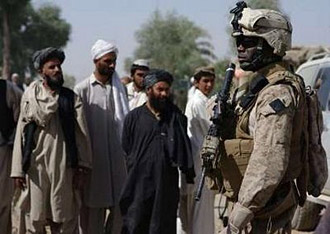
|  |  |  Editorials | Issues | November 2009 Editorials | Issues | November 2009  
The Stress of War: US Military Divorces Increasing
 Pauline Jelinek - Associated Press Pauline Jelinek - Associated Press
go to original
November 28, 2009


| | Figures show a slow but steady upward trend in recent years as American forces fought the two wars in Iraq and Afghanistan. (Reuters) |  |
The divorce rate in the armed forces continues to edge higher, despite efforts by the military to help struggling couples.

There were an estimated 27,312 divorces among roughly 765,000 married members of the active-duty Army, Air Force, Navy and Marine Corps in the 12 months that ended Sept. 30, the Pentagon reported Friday.

That's a divorce rate of about 3.6 percent, compared with 3.4 percent a year earlier, according to figures from the Defense Manpower Data Center. Marriages among reservists failed at a rate of 2.8 percent compared to 2.7 the previous year.

Air Force Maj. April Cunningham, a Defense Department spokeswoman, said the latest year-to-year change was relatively small because the services have made available programs focused on strengthening and enriching family bonds among couples.

"We believe these programs are instrumental in mitigating the stresses deployment places on marriages," said Cunningham.

Still, the figures show a slow but steady upward trend in recent years as American forces fought the two wars in Iraq and Afghanistan.

Friday's reported 3.6 percent rate is a full percentage point above the 2.6 percent reported in late 2001, when the U.S. began sending troops to Afghanistan in response to the Sept 11 terrorist attacks.

As in previous years, women in uniform suffered much higher divorce rates than their male counterparts: 7.7 percent compared to 3 percent for men in 2009.

There's no comparable annual system for tracking the national or civilian divorce rate, though the Centers for Disease Control said in 2005 that 43 percent of all first marriages end in divorce within 10 years.

"Every marriage has controllable and uncontrollable factors," said Joe Davis, spokesman for the Veterans of Foreign Wars. "But when you interject eight years of war, preparing for war, being at war, coming home and having to think about going back to war again — and when you have children — it just has a tremendous impact on the family unit."

Davis said that the military prides itself on taking care of military families.

Programs run by chaplains, mental health officials and family services agencies provide service members access to retreats, couples' counseling, workshops and other programs aimed at easing the strain of separation. Troops and spouses are advised on how long absences may affect family relationships and how to adjust to problems that arise after homecomings.

"Still, at the end of the day, it's that one mother or father who has to go home and close the door and be home alone with their children," said Davis. "There's nothing you can do that will end the stress of having a loved one at war ... until the war ends."

Critics complain annually that the divorce rate reported by the Pentagon comes nowhere close to depicting the damage done to marriages and families by the two ongoing wars.

"Those numbers seem extremely conservative and they are not at all representative from what we're hearing from the community," said Paul Rieckhoff, who served with the Third Infantry Division and founded the Iraq and Afghanistan Veterans of America.

"Every time my unit got deployed, we saw a whole new round of divorces," he said, estimating that the marital fallout is closer to double digits than to the Pentagon rate.

The Pentagon number doesn't count veterans, who divorce after leaving the services, let alone reflect other possible wartime consequences on families, such as increases in alcoholism or the toll on orphaned or emotionally stressed children of troops.

And the statistics do not speak to troubled but intact marriages. In an Army battlefield survey taken in Iraq in the spring, nearly 22 percent of young combat soldiers questioned said they planned to get a divorce or separation, compared to 12.4 percent in a survey conducted in 2003. |

 |
|  |



